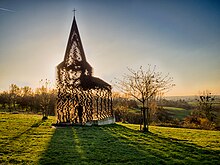Reading Between the Lines
Reading Between the Lines (German: Reading Between the Lines; also: Doorkijkkerk , in German: Durchguckkirche ) is an art installation at Borgloon in the Belgian province of Limburg . The partially transparent installation in the form of a typical local church is intended to stimulate discussions about the role of the church.
history
The art installation Reading Between the Lines is the work of Belgian architects Pieterjan Gijs and Arnout Van Vaerenbergh. It was created as part of an exhibition organized by the art museum Z33 Kunstencentrum in public space at various locations in the vicinity of the cities of Borgloon and Heers . The steel plates used for the construction were cut into shape by a local company within seven months according to the architects' plans and then assembled for installation within four weeks. Completion took place on September 24, 2011.
description
The architects chose the design of the art installation based on a local church, which was recorded using laser scans. The installation consists of an elongated, rectangular structure, above the entrance of which there is a tower with an articulated helmet roof on the eastern end. It was built from 100 horizontal steel plates, which are separated from each other by 2000 small steel columns, resulting in a transparent structure. The ratio of 1 centimeter of steel plate to 9 centimeters of recess makes it possible to achieve the shape of a church and at the same time reveal the view of the landscape. A total of 30 tons of Corten steel were used to build the installation, which stands on a concrete foundation and reaches a height of 10 meters.
If the installation is viewed from a lowered or raised position, it appears like a solid structure due to its construction of many horizontal panels. When viewed directly at the same height, however, the installation appears largely transparent and reveals the landscape behind.
interpretation
According to the architects, the installation should not express a point of view on religious issues, but rather allow space for interpretation. Ronan J. O'Shea writes in The Guardian that the art installation stimulates viewers to reflect on the role of the church in the modern world. The installation allows, among other things, the interpretation of the church as a place of art, the interpretation as superfluous space due to the partially almost completely transparent structure and the interpretation as a place of worship due to the shape of a typical local church. Wanda Lau, on the other hand, emphasizes in Architect Magazine that the installation draws attention to the fact that the church can be the fulcrum in a person's life on the one hand, or simply a physical structure that blends in with its surroundings on the other.
gallery
Web links
Individual evidence
- ^ A b Ronan J. O'Shea: Sculpture from the saddle: a cycling and art tour of Belgium. In: The Guardian . May 7, 2019, accessed June 3, 2021 .
- ↑ a b c d e f g Wanda Lau: Reading Between the Lines for a Church Made of Metal. In: Architect Magazine. October 3, 2012, accessed June 3, 2021 .
- ↑ a b Reading Between the Lines / Gijs Van Vaerenbergh. In: ArchDaily. November 27, 2012, accessed June 3, 2021 .
- ↑ a b Eric Grundhauser: Reading Between The Lines. In: atlasobscura.com. Accessed June 3, 2021 .
Coordinates: 50 ° 47 '38.8 " N , 5 ° 21' 6.3" E




